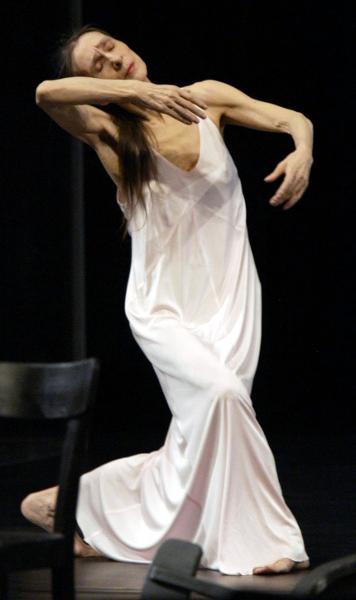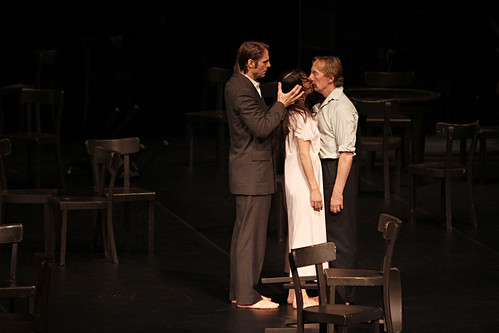"I'm not interested in how people move; I'm interested in what makes them move." - Pina Bausch

Bausch’s work continually delivers messages about societal conventions and human behavior (especially in regard to gender roles); it’s so raw and timeless, that it is certainly worthy of extensive analysis outside of the dance and theatre world. David W. Price, Ph.D., of Emory University describes Bausch’s tanztheater as a performance art that “reveals the body as the site of a social inscription – the body on which the writing of the politics of gender reveals itself in performative acts” (323). Her “dialectical examination” of the body as a political and social entity registers with much of the material I researched for a previous gender studies class. Societal conventions become so ingrained in us that it can become very hard to detect what is nature and what is nurture (ex: children's toys; Why is it assumed that young girls have a predisposition to Barbie, and young boys to G.I. Joe?).
Bausch examines these conventions and obscures them into movement and expression for her dance theatr e. An excellent example of this is Bausch’s 1978 work, Café Müller. This piece is about inadequate and inept attempts between men and women to establish relationships. It takes place in a
e. An excellent example of this is Bausch’s 1978 work, Café Müller. This piece is about inadequate and inept attempts between men and women to establish relationships. It takes place in a
café, but the maze of tables and chairs on the stage seem to represent more than just a place to eat. Bausch has obscured and abstracted this relatable, seemingly neutral situation in a way that shows how social structures inhibit and alienate individuals (specifically their movement and development). Bausch expands on the dichotomy and estrangement between the sexes by having women adopt schizoid behaviors, indicative of isolation, despair, and mental illness. This raises the question, why is it necessary, or even acceptable, for women to disfigure themselves in order to participate in society?
 e. An excellent example of this is Bausch’s 1978 work, Café Müller. This piece is about inadequate and inept attempts between men and women to establish relationships. It takes place in a
e. An excellent example of this is Bausch’s 1978 work, Café Müller. This piece is about inadequate and inept attempts between men and women to establish relationships. It takes place in aMan and woman succumbing to societal conventions.
café, but the maze of tables and chairs on the stage seem to represent more than just a place to eat. Bausch has obscured and abstracted this relatable, seemingly neutral situation in a way that shows how social structures inhibit and alienate individuals (specifically their movement and development). Bausch expands on the dichotomy and estrangement between the sexes by having women adopt schizoid behaviors, indicative of isolation, despair, and mental illness. This raises the question, why is it necessary, or even acceptable, for women to disfigure themselves in order to participate in society?
The questions that arise from Bausch’s work are endless. Her tanztheater has no resolution, so it causes her audience to think and reevaluate what they thought they already knew. Of course, there is always resistance to work as radical as hers; one review suggested that Café Müller be called “six go bonkers in an eaterie.” Interestingly enough, this same review praised her rendition of The Rite of Spring as "compelling" and "one of the best". Vaslav Nijinsky's original choreography for the Ballets Russes in 1913 met a large amount of resistance and even riotous behavior due to its shocking departure from all previous ballet choreography. Isn't it interesting how Rite has now become the classic against which contemporary artists are being compared?

I think that Pina Baush's choreographic ways are very fascinating and innovative. I am especially drawn to her usage of the body as a social and political instrument of conveying messages, and not just a physical tool. These posts about Bausch inspire me to do more abstracting in my choreography, because I find it to be more effective in conveying a message of any kind.
ReplyDeleteI found Pina Baush's movement vocabulary to be very interesting. Her work is passionate and intense, both of which is highlighted through her use of the body. Her interpretation of "The Rite of Spring," was fantastic. The energy and quality of movement Baush created for the chosen virgin was remarkable and captivating to watch.
ReplyDeleteHer work is about making a statement, which is something I believe modern dance should do (I believe every dance says something). Baush's particular statements tend to be political or social which I find to be intriguing as a viewer. Her choreography is creative and her work with abstraction of movement and elements allow her pieces to express the desired statement. Though I do not believe I would ever want to dance this type of technique, I appreciate her work and what it has done in shaping modern dance.
L- Your integration of your thoughts from gender studies to your response to Bausch adds a strong dimension to this blog. Excellent links to souces that demonstrates a solid understanding of concert dance history.
ReplyDeleteI agree with Leah that the use of abstraction is very strong and effective in Bausch's works. It's very interesting to see how that has developed from the start of concert dance where pieces were a story through times of having no specific message or story line to the point of having one but abstracting it to such a large extent. It really shows the possibilities that have been created through dance and I think that Bausch's works have really catalyzed these. Her statements are strong and it is from this I'm sure that she has gained the great amount of respect that she has.
ReplyDeleteance Classes For Contemporary Dance in bangalore.Contemporary With the aim of Dance Training Services in bangalore . Save time! Get best deals for Contemporary Dance at-
ReplyDeleteBest Choreographers In India
Best Contemporary Choreographers
Best Contemporary Choreography
India's Best Contemporary Choreographers
amazing post https://www.itdaymississippi.org/2020/08/custom-name-necklaces/
ReplyDelete